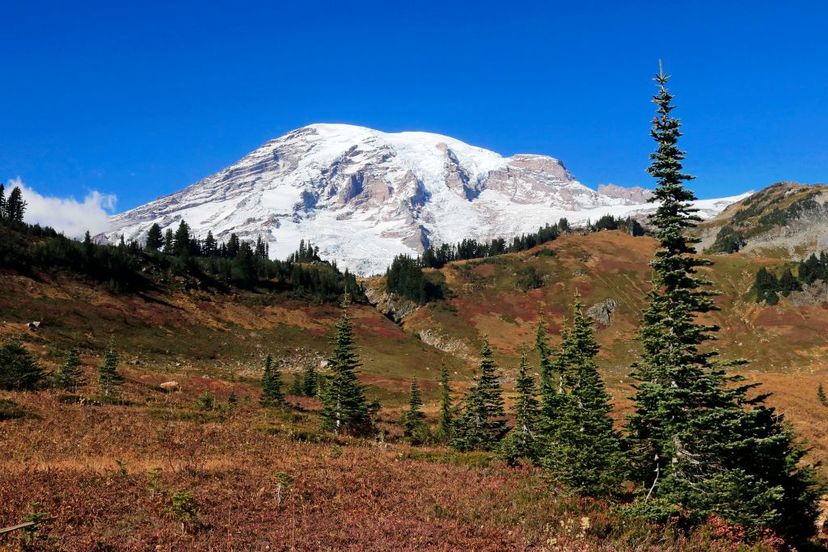
Advertisement
Ascend the Tallest Peak in the Evergreen State
Mount Rainier National Park, the fifth national park established, preserves more than 200,000 beautiful acres, including all of Mount Rainier. This 14,411-foot stratovolcano is the tallest mountain in Washington state. The park is home to a variety of ecosystems, like glaciers, meadows, and forests. There are also many hiking trails with waterfalls, cliffs, and natural bridges.
Mount Rainier park rangers give free educational tours, as they have for most of the park’s existence. Activities range from informal, educational talks to evenings telling stories around the campfire.
Advertisement
Visiting Mount Rainier National Park
The park is open all year, but the most popular time to visit is July and August when wildflowers are in full bloom and the weather is warm and dry. But summer isn’t the only time to visit the park. Fall brings deep and brilliant hues that travel up the mountain and down deep into the valleys. Spring brings majestic and ephemeral views of the crystal waterfalls.
Visitors should keep in mind that during the winter, the only park entrance is Nisqually Entrance. It is best to check road statuses before making the trip.
The fee to enter the park is $15 per vehicle or $5 per person. The fee gives visitors seven-day access to the national park. Campground fees start at $12 per night and can be reserved in advance. Reservations are recommended during peak season. For those who don’t wish to camp, there are two hotels located inside the national park: National Park Inn and Paradise Inn.
All visitors who plan to climb above 10,000 feet or on any glaciers require a climbing permit. Passes can be purchased at the Paradise Ranger Station, White River Wilderness Information Center, and the Carbon River Ranger Station.
The NPS recommends that all visitors have the “Ten Essentials” on hand at all times when visiting Mount Rainier National Park.
Advertisement
Wildlife in Mount Rainier National Park
The park is known for its Columbian black-tailed deer, black bears, and elk. The park has many species of wildlife, but in recent years park researchers have noticed a significant change in the behavior of the park animals. As a result of many people feeding the animals, the animals are becoming “food-conditioned.” This means instead of going out to hunt for food, animals are now seeking out people for food. Feeding animals can be anything from throwing food to them to leaving food out on picnic tables where animals can get to it.
When animals become food-conditioned, they lose their natural fear of humans, which can be very dangerous. The park advises that all visitors store food properly, keep clean campsites, place all garbage in animal-proof dumpsters, and resist the temptation to feed the animals. Mount Rainier recently created “Keep Wildlife Wild” buttons to encourage support.
Advertisement
History of Mount Rainier National Park
The area known as Paradise has some of the best views and wildflower meadows and is one of the most visited areas of the park. It is located on the south slope of Mount Rainier and is the location of the historic Paradise Inn, which was built in 1916, the Paradise Guise House, and the Henry M. Jackson Visitor Center. It is also one of the park’s snowiest places, receiving an average of 641 inches of snow a year. This allows for plenty of cross-country skiing, tubing, and snowshoeing during the winter.
Advertisement
Looking for more great national parks in Washington?
Try out these naturally beautiful spots nearby to enjoy even more flora and fauna:
Advertisement